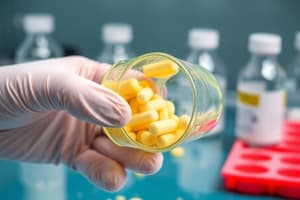Podcast
Questions and Answers
What is the primary reason for emphasizing aseptic techniques in a microbiology lab?
What is the primary reason for emphasizing aseptic techniques in a microbiology lab?
To prevent contamination and disease spread from pathogenic microorganisms.
Explain the significance of understanding host and parasite relationships in microbiology.
Explain the significance of understanding host and parasite relationships in microbiology.
It helps in understanding how diseases are caused and the mechanisms of infection.
Why is it necessary to use personal protective equipment (PPE) in a microbiology laboratory?
Why is it necessary to use personal protective equipment (PPE) in a microbiology laboratory?
To protect individuals from exposure to harmful microorganisms and prevent laboratory-acquired infections.
What action should be taken if an equipment breakage occurs in the lab?
What action should be taken if an equipment breakage occurs in the lab?
Describe the protocol that must be followed before and after using an inoculating loop.
Describe the protocol that must be followed before and after using an inoculating loop.
What is the best prevention method to mitigate communicable diseases according to the course?
What is the best prevention method to mitigate communicable diseases according to the course?
Why is it important to keep the workbench free from clusters of objects?
Why is it important to keep the workbench free from clusters of objects?
What is the first step you must take before starting any laboratory exercise?
What is the first step you must take before starting any laboratory exercise?
What is the primary purpose of a microscope in a laboratory setting?
What is the primary purpose of a microscope in a laboratory setting?
How does a freezer differ from a refrigerator in terms of material preservation?
How does a freezer differ from a refrigerator in terms of material preservation?
Why is a hot air oven effective for sterilization?
Why is a hot air oven effective for sterilization?
What is the function of biosafety cabinets in the laboratory?
What is the function of biosafety cabinets in the laboratory?
What is the use of a pH meter in laboratory procedures?
What is the use of a pH meter in laboratory procedures?
Describe the role of Durham tubes in fermentation media.
Describe the role of Durham tubes in fermentation media.
What is the purpose of an inoculation loop?
What is the purpose of an inoculation loop?
How are microtitre plates utilized in laboratory testing?
How are microtitre plates utilized in laboratory testing?
Why is it essential to tie back long hair and wear fitted clothing in a microbiology laboratory?
Why is it essential to tie back long hair and wear fitted clothing in a microbiology laboratory?
What is the purpose of sterilizing inoculating needles and loops before and after use?
What is the purpose of sterilizing inoculating needles and loops before and after use?
Describe the correct method for handling bottle stoppers in a microbiology lab.
Describe the correct method for handling bottle stoppers in a microbiology lab.
What is the recommended procedure for flaming the loop before using it?
What is the recommended procedure for flaming the loop before using it?
Explain why the mouth of the tube must be flamed after inserting the inoculating loop.
Explain why the mouth of the tube must be flamed after inserting the inoculating loop.
What are two key pieces of equipment used for sterilization and culturing in a microbiology lab?
What are two key pieces of equipment used for sterilization and culturing in a microbiology lab?
At what temperature and pressure does an autoclave operate effectively for sterilization?
At what temperature and pressure does an autoclave operate effectively for sterilization?
Why should lab personnel work with both hands during inoculation procedures?
Why should lab personnel work with both hands during inoculation procedures?
Flashcards
Aseptic Procedures
Aseptic Procedures
Methods to prevent contamination in microbiology.
Inoculating Tools
Inoculating Tools
Needles and loops used for transferring cultures.
Flame Sterilization
Flame Sterilization
Using fire to sterilize inoculating tools and containers.
Culture Handling
Culture Handling
Signup and view all the flashcards
Autoclave
Autoclave
Signup and view all the flashcards
Incubator
Incubator
Signup and view all the flashcards
Microbial Culture
Microbial Culture
Signup and view all the flashcards
Personal Hygiene in Lab
Personal Hygiene in Lab
Signup and view all the flashcards
Aseptic technique
Aseptic technique
Signup and view all the flashcards
Disinfection
Disinfection
Signup and view all the flashcards
Sterilization
Sterilization
Signup and view all the flashcards
Pathogenic organisms
Pathogenic organisms
Signup and view all the flashcards
Epidemiology
Epidemiology
Signup and view all the flashcards
Immunity
Immunity
Signup and view all the flashcards
Personal protective equipment (PPE)
Personal protective equipment (PPE)
Signup and view all the flashcards
Laboratory rules
Laboratory rules
Signup and view all the flashcards
Microscope
Microscope
Signup and view all the flashcards
Refrigerator
Refrigerator
Signup and view all the flashcards
Freezer
Freezer
Signup and view all the flashcards
Hot Air Oven
Hot Air Oven
Signup and view all the flashcards
Biosafety Cabinets
Biosafety Cabinets
Signup and view all the flashcards
Vortex
Vortex
Signup and view all the flashcards
PH Meter
PH Meter
Signup and view all the flashcards
Centrifuge
Centrifuge
Signup and view all the flashcards
Study Notes
Introduction to Practical Course in Microbiology and Immunology
- This course introduces practical applications of microbiology and immunology.
- Students will learn basic microbiology knowledge, aseptic techniques, disinfection, and sterilization.
- Handling materials contaminated with pathogenic organisms is a key component of the course.
- The course aims to teach the biological characteristics of important disease-causing bacteria.
- The relationship between microorganisms and diseases will be emphasized.
- Students and staff must understand how microorganisms can cause disease and practice aseptic technique.
- Students should be knowledgeable of epidemiology, pathogenesis, the host-parasite relationship and the development of resistance to infection.
- The importance of prevention over cure is also highlighted.
General Laboratory Rules
.
- Eating, drinking, and smoking in the lab are prohibited, inclu d ing mouth pipetting.
- Personal protective equipment (PPE) like lab coats and gloves is mandatory.
- Barefoot entry is not allowed; shoes must be worn.
- Report any equipment breakage to instructors promptly.
- Keep the work area clear of unnecessary equipment.
- Disinfect work surfaces before and after use.
- Wash hands with soap and water before leaving the lab and whenever there's potential contamination.
- Cultures cannot be removed from the lab without instructor permission.
Aseptic Procedures in Microbiology Laboratory
- Procedures in microbiology labs should minimize the risk of contamination to oneself, the work area and cultures.
- Inoculating needles and loops must be sterilized in a flame before and after use.
- Bottles and tubes should not be touched unnecessarily.
- Never put the lids/tops on benches.
- Always flame the mouths of bottles and tubes before and after use.
Aseptic Technique in Microbiology
- Flame loops in Bunsen burners/spirit lamps until red hot before and after use.
- Introduce loops slowly to prevent spraying of materials.
- Cool the loop down before picking cultures or specimens.
- Hold the culture plate or tube while flaming the mouth, using correct hygiene procedures.
- Replace lids/tops after use.
- Sterilize tools thoroughly after use.
- Everything and every surface in the lab is potentially infectious; exercise caution.
Important Equipment in Microbiology Laboratory
- Microbiology is a broad scientific discipline involving techniques from microscopy to genetic analysis and much more.
- The wide variety of techniques and testing require varied and specialized equipment.
- Subsequent slides list the equipment and reagents for microbiological examination.
Autoclave
- Equipment used for sterilizing glassware and media.
- Effective sterilization occurs at 121°C and 15 Psig pressure for 15 minutes.
Incubator
- Used for bacterial and fungal cultures (prokaryotic and eukaryotic cells).
Microscope
- Observe tiny organisms that are not visible to the naked eye.
- Aids in magnification and resolution.
Refrigerator
- For sample, culture, media, and sensitive materials preservation.
Freezer
- For sample, culture, media, and sensitive materials preservation at temperatures below freezing point of water
Hot Air Oven
- Used for sterilizing materials not suitable for moist heat.
- Effective sterilization occurs at 160-300°C.
Biosafety Cabinets
- Prevention of infection, especially with highly infectious bacteria like Bacillus anthracis, various mycobacterium species, and aspergillus species.
Petri dishes/culture plates/agar plates
- Support culture medium, contain cultures and specimens.
- Sterile disposable swabs, e.g., for specimen collection;
- Serological test slides (use with immunoassays).
- Universal bottles are used for sample collection and media preparation.
Vortex
- Mixing liquids in test tubes.
Magnetic Stirrer
- Mixing liquids in beakers and conical flasks.
pH Meter
- Measure pH of media and reagents.
Candle Jar
- For cultivating anaerobic organisms.
Centrifuge
- Separate supernatant and pellet materials.
- Used for preserving cell samples, viruses, and fungal spores.
Durham tubes
- Detect gas production in fermentation media.
- Used for specific microbiological tests as part of overall lab testing procedures.
Haematologic (blood) Plates
- Test for viral cultures.
Inoculation Loop
- Transfer bacterial or fungal cultures.
Microtitre Plates
- Used in ELISA tests.
Canister
- Carrying and storage of petri dish equipment.
Washing Bottles
- Used to wash equipment, commonly using distilled water.
Cool Box
- Transport samples.
Vacutainer tubes
- Blood sample collection. W
Measuring Cylinder
- Measure specific volumes of reagents/water.
Tally Counter
- Count bacteria/colonies.
Micropipette
- Measured volumes.
Water Bath
- Warms culture media
- Cannot be autoclaved
- Used for maintaining a consistent temperature during certain procedures.
Weighing Balance
- Measuring mass of media, chemicals, and reagents.
Syringes
- For blood specimen collection.
Bijou Bottles
- Hold culture medium and solutions for biochemical tests.
Safety Cabinet
safety cabinet is used as a critical piece of equipment in microbiology laboratories to handle potentially infectious materials safely.
Incubator(Details)
- Copper steel chambers facilitate the circulation of warm water/air by electrical current, providing optimal growth conditions for microorganisms in the lab.
Electronic Balance
- Weighs chemical substances accurately in lab settings.
Petri Plate(Details)
- Developed by J.R. Petri.
- Used for culturing various types of microorganisms in a controlled environment and observed for certain characteristics expected from the organism under study.
Spirit Lamp
- Heat chemical substances (e.g., within apparatus)
Bunsen Burner
- Sterilizes metallic instruments, glass tubes, and flasks, heating components for important procedures.
Centrifuge (Details)
- Separates sediments (typically biological or chemical) from a suspension.
Autoclave (Details)
- Maintains high pressure and temperatures to effectively sterilize materials during lab procedures.
- Sterilizes glassware, media, etc., for various microbiology lab procedures.
Inoculation Loop (Details) /
- Transferring microbiological growth, facilitating lab procedures.
Studying That Suits You
Use AI to generate personalized quizzes and flashcards to suit your learning preferences.



